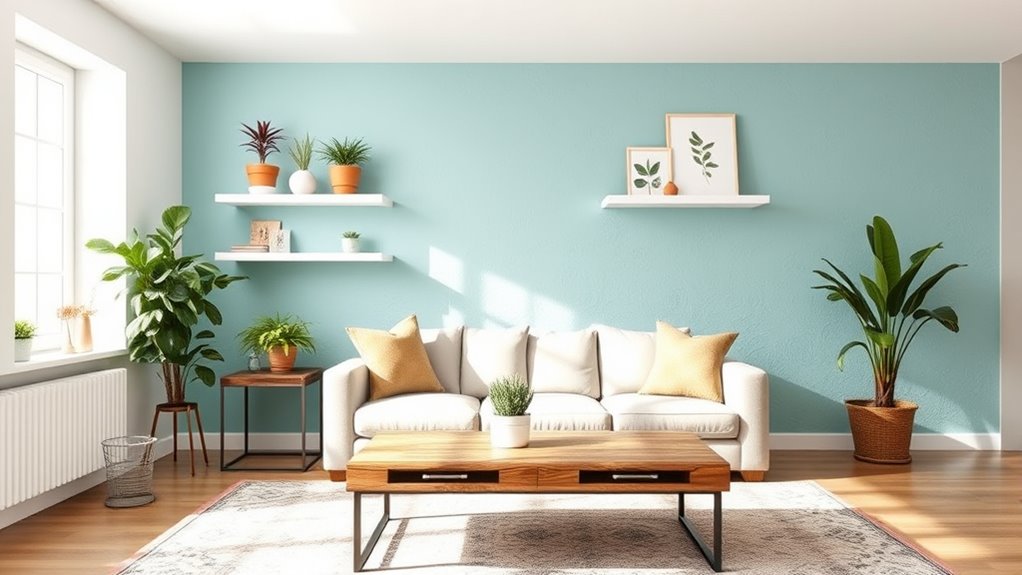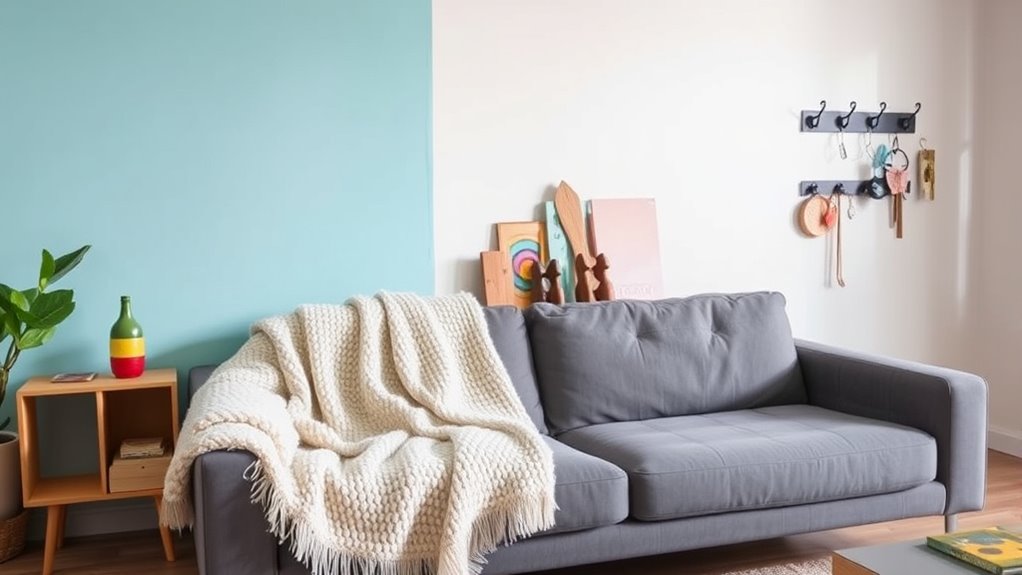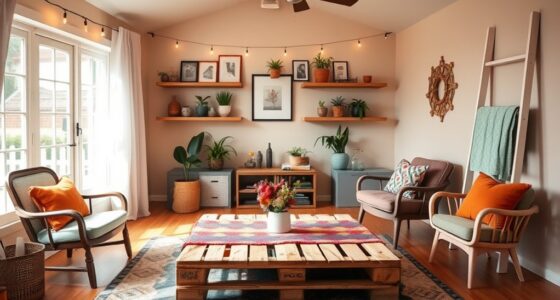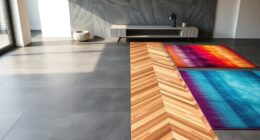Looking to give your home a fresh look without breaking the bank? You can easily accomplish quick, impactful upgrades under $50 by sprucing up hardware, painting an accent wall, or swapping out switch plates for a modern touch. Thrift stores and repurposing furniture can also add personality. Focus on safety and planning to make the most of your budget. Keep exploring for more simple, affordable ideas that can transform your space with minimal cost.
Key Takeaways
- Focus on small, impactful updates like painting an accent wall or replacing hardware to refresh spaces affordably.
- Use budget-friendly materials and thrifted finds to add style without exceeding $50.
- Prioritize safety by wearing protective gear and following DIY guidelines during projects.
- Repaint or repurpose existing furniture for a quick, cost-effective upgrade.
- Enhance organization with wall-mounted systems or storage jars for a cleaner, more functional home.

Thinking about sprucing up your home without breaking the bank? You’re in the right place. DIY home upgrades are a fantastic way to refresh your space without spending a fortune. To get started, it’s important to focus on budget-friendly tips that maximize impact while keeping costs low. First, plan your projects carefully. Look around your home and identify areas that need a quick facelift—new paint on a wall, updated hardware, or a fresh coat on tired furniture. These simple swaps can dramatically change the vibe of a room without draining your wallet.
Revamp your home affordably with simple DIY projects and budget-friendly upgrades.
Before diving in, make sure you’re familiar with DIY safety guidelines. Working on home projects can be rewarding, but safety should always come first. Wear protective gear like gloves and goggles, especially when handling tools or chemicals. Keep your workspace tidy to avoid accidents, and read all instructions and labels on products before use. If you’re using power tools, take the time to learn proper operation techniques. Remember, rushing can lead to injuries or mistakes that end up costing more in the long run. When in doubt, consult tutorials or ask for advice from experienced DIYers online.
Once safety is squared away, focus on projects that are quick and simple but give noticeable results. Painting a single accent wall in a bold color is an excellent example. It’s affordable, and with just a few hours of work, you can dramatically change the atmosphere of a room. Replacing outdated cabinet hardware in the kitchen or bathroom is another budget-friendly tip. These small updates are inexpensive but have a huge visual impact. If you’re feeling more ambitious, consider installing new light fixtures or swapping out old switch plates for modern styles. Incorporating wall organization systems can also help you declutter and add visual interest to your space. Additionally, investing in DIY safety guidelines can help prevent accidents and ensure your work is both safe and effective. Being aware of building codes and regulations can prevent costly mistakes and ensure your upgrades are compliant with local standards.
Another tip is to repurpose existing furniture or decor instead of buying new pieces. Give an old table a fresh coat of paint or transform a set of jars into stylish storage containers. Thrift stores can also be treasure troves for affordable decor items that you can personalize. When it comes to DIY safety guidelines, always double-check that your tools and materials are in good condition. Don’t rush any step—take your time to ensure each upgrade is done properly and safely. This approach not only saves you money but also ensures your work lasts longer. Incorporating cost-effective materials can help you stretch your budget further while achieving professional-looking results. Using eco-friendly and durable materials can enhance the longevity and style of your upgrades. Moreover, understanding the importance of space and organization can make your home more functional and comfortable in the long run. With a little planning, a focus on safety, and a creative mindset, you can enhance your home without overspending. DIY projects are all about making your space more comfortable and stylish in a way that’s satisfying and cost-effective. So roll up your sleeves, follow these tips, and enjoy the process of transforming your home on your own terms.
Frequently Asked Questions
What Are the Safest Tools for Beginner DIY Projects?
When starting DIY projects, you want to prioritize safety. The safest tools for beginners include a cordless drill, a handsaw, and a screwdriver, as they’re easy to control. Always wear safety gear like goggles and gloves, and learn proper tool maintenance to keep them in good condition. Using the right tools safely helps prevent accidents and ensures your projects go smoothly. Stay cautious and enjoy your DIY journey!
How Can I Budget Effectively for Home Upgrades?
Think of your budget like a garden; careful planning helps it flourish. To budget effectively, start with clear budget planning, setting realistic goals for your home upgrades. Use expense tracking tools to monitor spending and prevent costs from spiraling out of control. Prioritize projects, compare prices, and stick to your plan. This way, you’ll nurture your home improvements without draining your finances, making your investment grow steadily.
Which Materials Are Most Eco-Friendly for DIY Projects?
When choosing eco-friendly materials for your DIY projects, you should prioritize recycled materials and organic paints. Recycled materials, like reclaimed wood or recycled metal, reduce waste and conserve resources. Organic paints are free from harmful chemicals and have low VOC content, making them safer for you and the environment. By selecting these options, you can create beautiful, sustainable upgrades that minimize your ecological footprint and promote healthier indoor air quality.
How Do I Prevent Damage to Existing Decor During Upgrades?
To prevent damage to your existing decor during upgrades, focus on protecting decor with proper masking techniques. Cover furniture and walls with painter’s tape, plastic sheeting, or drop cloths before starting. Be careful when using tools or paints to avoid splatters and scratches. Taking these precautions guarantees your decor remains intact while you work efficiently, keeping your space looking fresh and undamaged throughout your DIY project.
What Are Some Hidden Costs to Watch Out For?
When considering upgrades, watch out for hidden costs like unexpected expenses that can pop up unexpectedly, and permit fees, which many overlook. You might also encounter additional costs for tools, materials, or disposal. Always plan a contingency budget to cover these surprises, and research local regulations to avoid fines or delays. Being prepared helps you stay on track and prevents your project from going over budget.
Conclusion
Now that you’ve got these budget-friendly upgrades under your belt, your home is like a blank canvas turned vibrant masterpiece. Each quick fix adds a splash of personality and charm, proving that you don’t need to spend a fortune to make a big impact. Think of your space as a garden—small, thoughtful tweaks are like watering and nurturing, helping your home bloom beautifully without breaking the bank. Get ready to enjoy your refreshed, personalized sanctuary!









